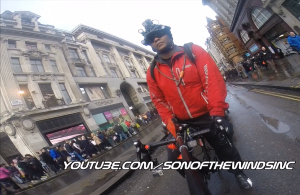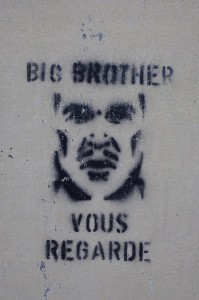by Derek Morrison
Now in any space or event
Big Brother can watch you vent
Whether you’re inside, or outdoor
There’s no hiding place any more
Meteor strike or plane crash
All now captured from the dash
And if you cause some offence
Big Brother has the evidence
A fleeting moment of no constraint
But a lifetime to feel the taint
Your unwilling spot as YouTube star
Shows the world you went too far
The virtual mob smelt the blood
A comment trickle became a flood
A social position once enjoyed
Social media forever destroyed
Ninety Eighty Four has passed
Dystopian fiction it was classed
Big Brother defined what was true
Now Big Brother, is me and you.
[To listen to this verse select below]
Commentary
In liberal democracies it’s important that we sustain a healthy counterweight to the the level of surveillance that technology makes possible on a state’s citizenship. For example, it is suggested that the UK has 20% of the world’s CCTV cameras despite having circa 1% of the world’s population. Some of these CCTV cameras are operated by local authorities and are street facing. There are certainly potential civil liberties issues but sometimes such cameras capture irrefutable evidence that could not have been provided any other way, e.g. Bus Driver Deliberately Hit Cyclist Sent to Prison (2012). Even more controversially, in the UK, there is an extensive network of Automatic Number Plate Recognition (ANPR) cameras which enables vehicles to be tracked in real time by the police or security services. The ANPR network consists of fixed cameras and those fitted to police vehicles.
But the main thrust of the poem is not the surveillance society as envisaged in George Orwell’s short novel 1984. Instead it attempts to convey the irony that Orwell’s Big Brother may as (or more) likely to be realised by “the people” – even (or particularly) in liberal democracies – than by state officialdom. The synergy of highly portable media gathering devices with social media has created both a powerful vehicle for both good, and ill.
Why?
Because the combination can throw into the spotlight what was previously transient, ephemeral and hidden. The near ubiquity of media gathering devices in the form either of street cameras, smartphones or more recently dashboard camera (dashcam), helmet cams, and body cams, means that there is a likelihood that situations or events can now captured and are likely to be shared, willingly or unwillingly.
For example, consider the 2013 meteor strike in Russia. At one time we would have to be content with press accounts and conjure the images within our heads. Now, however, the proclivity for mounting dashboard cameras in Russian cars to provide evidence in event of the all too frequent crashes resulted in multiple video recordings of the meteor strike (see Links and Resources).
Similarly, the more recent February 2015 plane crash in Taipei, Taiwan was captured in frightening detail by a dashboard camera (see Links and Resources).
The two examples above illustrate how technologies now enable anyone to contribute to the public record of events, albeit sometimes tragic ones. That is one type of evidence.
 A more activist approach to ‘evidence’ gathering has also been made possible by highly portable media gathering technologies. For example, one now well known London cyclist Lewis Dediare (alias Traffic Droid), after a serious accident equipped his cycle with all round cameras and uses these to record his now campaigning daily commutes. He then disseminates these on YouTube as vivid demonstrations of the sometimes appalling dangerous and antisocial behaviour of some road users. As well as the name and shame aspects of his chosen form of activism some of his media captures are used as evidence in legal proceedings (see Links and Resources).
A more activist approach to ‘evidence’ gathering has also been made possible by highly portable media gathering technologies. For example, one now well known London cyclist Lewis Dediare (alias Traffic Droid), after a serious accident equipped his cycle with all round cameras and uses these to record his now campaigning daily commutes. He then disseminates these on YouTube as vivid demonstrations of the sometimes appalling dangerous and antisocial behaviour of some road users. As well as the name and shame aspects of his chosen form of activism some of his media captures are used as evidence in legal proceedings (see Links and Resources).
There have been a number of cases where unreasonable, and sometimes unlawful, behaviour on the part of police in democratic countries has been evidenced by video captures by members of the public, e.g. the death of the newspaper vendor Ian Tomlinson who was in the wrong place at the wrong time during the G20 protests in London, 1 April 2009. At the time of writing this poem, the death by shooting of Walter Lamer Scott by a South Carolina policeman on 7 April 2015 was graphically recorded by a witness using a smartphone.
All such events are always tragic. We should also reflect, however, on how what was once easy to hide from the public eye or recast into a more convenient version of the truth, is now being thrust into the spotlight of various formal and informal media fora. Governments and public agencies and may well find this an uncomfortable experience, but unlike repressive regimes they are expected to reform themselves rather than shoot the messengers – aren’t they?
But such reform cuts two ways. For example, the police are also beginning to employ body worn cameras to record their interactions with the public with apparently positive results on the behaviour of both the police and public (see Links and Resources). The police gather video ‘evidence’. The public gather video ‘evidence’. But perhaps better cloaking in the armour of videos than the armour of batons, bullets, or lies.
Synergies between the police and public are also being made possible by the new media. The police cannot, and in a healthy society should not, be everywhere. But the public are and so it is they who are more likely to be there at the time of the untoward event, and increasingly, capturing it on their media device. What is the legal status of such evidence? Increasingly, acceptable and at times police forces will actively solicit it. In the UK, the marked decrease in traffic police has decreased the likelihood of traffic offences being detected. Yet with the advent of dashcams and other devices members of the public appear more than willing to back up their reports of the selfish and the stupid to the police with date and time stamped video footage. Such footage is sometimes brokered by third parties with a commercial interest, e.g. PoliceWitness.com
Earlier I offered the example of Traffic Droid where the campaigning cyclist Lewis Dediare recorded his interactions on London’s busy roads which he has resulted in some successful prosecutions. Lewis is an activist not afraid to confront and publicize what he considers the unreasonable, selfish, or outright dangerous behaviour of other road users. He is undoubtedly a controversial character, particularly to those he captures behaving badly who would rather he didn’t exist. On balance the good he does probably outweighs any turbulence he causes. But Traffic Droid also provides a useful segue to another category of less benign inhabitant of the new social media universe.
Emerging from the social media swamp comes the cyberbaiter, i.e. those who deliberately engineer a situation in order to engender a response in a target which is then captured and disseminated for the gratification of the perpetrator. Why? Immaturity, e.g. students targeting teachers; pleasure – bullying, or psychopathy; or revenge, i.e digital vigilantism. Whatever, the reason the cyberbaiter views social media as the vehicle for reinforcing their identity at the expense of others and that is going to do more than modify human behaviour – it’s going to distort it (see also Links and Resources).
In conclusion, I should declare an interest here. I’m out cycling on the busy UK road several times a week. There is never a day passes without at least one near miss or anti-social event from a small minority of other road users. They behave like that because they think they can and because there will be no consequence for them and are likely to do that in all aspects of their lives. Without some level of Big Brother such individuals would degrade the quality of life for everyone and so, on balance, perhaps my final line “Now Big Brother, is me and you” is not necessarily a bad thing.
Links and Resources
Dashcam compilation of meteor strike in Russia (2013) (YouTube)
Dashcam footage of Taipei, Taiwan plane crash (4 February 2015)
Traffic Droid Videos (YouTube)
You May Have Been YouTubed, Inside Higher Ed, 6 September 2006
Teachers Victims Of ‘Cyberbaiting’ By Pupils Looking For Revenge, Huffington Post, 17 November 2011
First scientific report shows police body-worn-cameras can prevent unacceptable use-of-force, University of Cambridge, 23 December 2014
Body Worn Video (Wikipedia)
